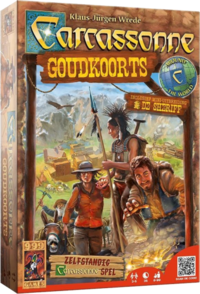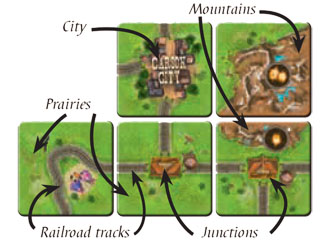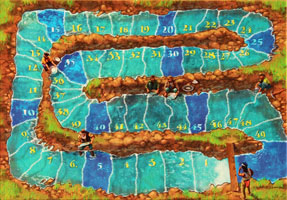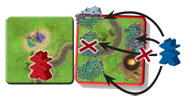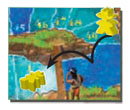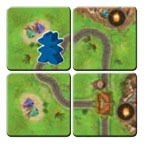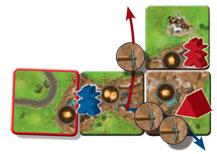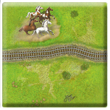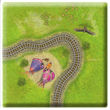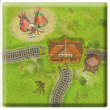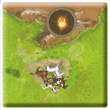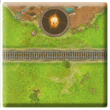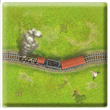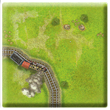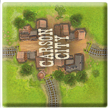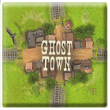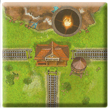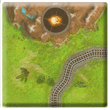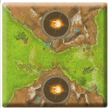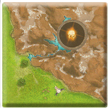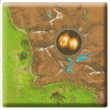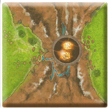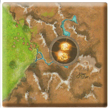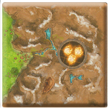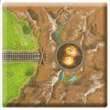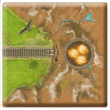Difference between revisions of "Gold Rush Base Game/nl"
(Created page with "* 3. Als door het aanleggen van een nieuwe tegel één of meer '''spoorwegen''', '''bergen''', of '''steden''' afgebouwd worden, vindt er een '''puntentelling''' plaats. If, by the placement of a new tile, one or more '''railroads''', '''mountains''', or '''cities''' are completed, they are evaluated and '''scored'''.") Tags: Mobile edit Mobile web edit |
(Created page with "== 1. Landtegel aanleggen ==") |
||
| Line 70: | Line 70: | ||
== 1. Landtegel aanleggen == | == 1. Landtegel aanleggen == | ||
De speler moet eerst een landtegel trekken van één van de gedekte stapels. Hij laat die aan alle spelers zien (zodat deze hem kunnen adviseren over “goede” plaatsen om die aan te leggen), en die dan volgens de volgende regels aanleggen: | |||
* The newly placed tile ({{ColorRed|red}}-bordered in the examples below) must be placed adjacent to at least one existing tile. Diagonal adjacency is '''not''' sufficient. | * The newly placed tile ({{ColorRed|red}}-bordered in the examples below) must be placed adjacent to at least one existing tile. Diagonal adjacency is '''not''' sufficient. | ||
Revision as of 15:17, 2 October 2022
Hoofdpagina > Goudkoorts > Goudkoorts basisspel
Algemene informatie en opmerkingen
Carcassonne: Goudkoorts, oorspronkelijk in Template:Year nl uitgebracht door Hans im Glück, is een spannend spel dat zich afspeelt tijdens de goudkoorts van het Wilde Westen, geschikt voor 2 tot 5 spelers vanaf 8 jaar.
Het Wilde Westen – Een land vol van ongetemde wildernis. De aanleg van de eerste spoorwegen in het gebied lokt de kolonisten uit hun tenten naar bloeiende mijnbouwsteden. Handel met de Indianen is lucratief; vooral wilde paarden zijn veel waar. Maar als er goudadres ontdekt worden in de bergen is de goudkoorts niet meer te stoppen - iedereen wil snel rijk worden. Maar pas op! Veel van de goudmijnen zijn al leeggeroofd door je concurrentie, en voordat je het weet zijn alle goudklompen verdwenen. Als je het spel speelt, krijgt iedereen goudkoorts!
Speelmateriaal
- 72 landtegels waaronder 1 starttegel met een afwijkende achterkant. Op de tegels staan spoorwegen met locomotieven; bergen met goudklompen; prairievlakten met Indiaanse tipi's en kuddes paarden; en western-steden.
- 25 pioniers - 5 in elk van de 5 kleuren. Pioniers kunnen ingezet worden als goudzoeker, spoorwerker, handelaar of boer. Eén pionier van elke kleur wordt als scorepion gebruikt.
- 5 goudzoekerstenten - 1 per kleur. De goudzoekerstenten worden gebruikt om je tent op te slaan in de bergen en daar goud te winnen.
- 1 scoretableau om het puntenaantal van de spelers bij te houden.
- Spelregels
- 63 mijnfiches - Deze worden tijdens het spel op tegels gelegd en door de spelers “opgegraven”. Op de voorzijde staan goudklompen (1, 2, 3 of 5 punten) of steengruis (0 punten) afgebeeld.
Overzicht
De spelers leggen om de beurt landtegels aan. Zo ontstaat een landschap van prairievlakten, bergen, steden en spoorwegen waarop de spelers hun pioniers zetten om punten te verdienen. Spelers zoeken in de bergen naar goud, of ze daar nu wel of niet een claim op hebben gelegd. Nadat alle landtegels zijn gelegd en de eindtelling heeft plaatsgevonden is de speler met de meeste punten de winnaar.
Voorbereiding
- De starttegel wordt midden op de tafel gelegd. Leg gedekt een mijnfiche op de berg. Schud de overgebleven landtegels en leg ze in een aantal gedekte stapels zodat alle spelers er gemakkelijk bij kunnen.
- Leg de overgebleven mijnfiches gedekt klaar. Het is het handigste om één speler aan te wijzen die deze fiches wanneer nodig neerlegt.
- Elke speler krijgt 5 pioniers en 1 tent in zijn kleur en zet 1 pionier als scorepion op veld 0 van het scoretableau.
- De jongste speler bepaalt wie het spel mag beginnen.[1]
Spelverloop
Er wordt met de klok mee gespeeld, beginnend met de startspeler. Tijdens zijn beurt voert iedere speler de volgende acties in de aangegeven volgorde uit:
- 1. De speler moet een landtegel trekken en die volgens onderstaande regels aanleggen (leg eventueel mijnfiches waar van toepassing).
- 2a. De speler mag een pionier op de zojuist aangelegde tegel zetten volgens onderstaande regels, OF
- 2b. De speler mag zijn eigen tent inzetten/verplaatsen op/naar een berg, OF
- 2c. De speler mag een mijnfiche pakken van de berg waar zijn tent staat. (Spelers mogen niet meer dan één van de acties uit stap 2 uitvoeren. Spelers mogen er wel voor kiezen om geen van de acties uit te voeren.)
- 3. Als door het aanleggen van een nieuwe tegel één of meer spoorwegen, bergen, of steden afgebouwd worden, vindt er een puntentelling plaats.
If, by the placement of a new tile, one or more railroads, mountains, or cities are completed, they are evaluated and scored.
Dan is de volgende speler aan de beurt.
1. Landtegel aanleggen
De speler moet eerst een landtegel trekken van één van de gedekte stapels. Hij laat die aan alle spelers zien (zodat deze hem kunnen adviseren over “goede” plaatsen om die aan te leggen), en die dan volgens de volgende regels aanleggen:
- The newly placed tile (red-bordered in the examples below) must be placed adjacent to at least one existing tile. Diagonal adjacency is not sufficient.
- Railroad tracks, mountains, and prairies must continue from this newly placed tile to existing adjacent tiles. In the rare case that a drawn tile cannot be legally placed, it is discarded from the game. The player draws a new Land tile to place instead.
Placing Mining Tokens
When a player places a Land tile depicting a mountain segment, one or more Mining tokens are immediately placed face-down on that mountain. The number of Mining tokens to be placed is equal to the number of gold nugget symbols on the newly placed tile. For the sake of clarity, all Mining tokens on a given mountain should be kept in a single face-down pile.
To ensure you do not forget to place these tokens, it is recommended that one player is assigned this important task.
2a. Placing Followers
Once a player has placed a tile, they may place a cowboy. The following rules apply:
- Only one cowboy may be placed
- The cowboy must come from her personal supply
- The cowboy must be placed on the newly placed tile
- The cowboy must occupy a single feature. As a ...
Note: For your first game, it is best to play without the farmers.
- No other cowboy (of another player or your own) may be present on the railroad, mountain, or prairie on which you place your cowboy. [2] This is best illustrated by the following examples:
If a player has no cowboys in their supply, they must continue to place tiles on their turn even though they cannot place cowboys. Do not worry: cowboys return to their players’ supplies when they are no longer needed on their respective railroads, mountains, and cities (further explained later).
2b. Pitch a Tent
Instead of placing a cowboy, a player may place their tent on the mountain segment of a tile, or move it from one mountain segment to another. The following rules apply:
- The mountain must not be completed
- The mountain segment of the tile must be vacant (a cowboy may occupy another segment of the same tile)
- Cowboys and tents may still occupy other segments of the same mountain
- The tent may occupy a newly placed tile or a previously placed tile
- There is no functional difference between placing a tent from one’s personal supply and moving a tent from one tile to another
2c. Mine for gold
On a turn in which a player chooses not to place a cowboy (2a) or pitch a tent (2b), they may choose to take the topmost Mining token from the mountain where their tent is located. It does not matter which other cowboys and tents occupy that mountain, or who possesses the most cowboys on that mountain. The Mining token a player acquires is placed facedown in front of them. A player may view the value of their acquired Mining tokens at any time, but they will only be added to the player’s score at the end of the game.
Attention: If, by the placement of a new tile, one or more railroads, mountains, or cities are completed, proceed to step 3 where these features will be evaluated and scored.
Otherwise, the next player clockwise begins their turn.
3. Scoring Completed Railroads, Mountains and Cities
If a road, mountain or city is "completed" by the placement of the land tile, it is now scored.
The Scoreboard
All players track their points with a cowboy on the provided scoreboard, with spaces marked 0-49. Should a player acquire 50 or more points in a game, they should lay their cowboy flat (as pictured to the right) to indicate that they have completed a lap of the scoreboard. In this way, a cowboy lying flat on space 1 of the scoreboard (as pictured to the right) indicates a score of 51 points. [3]
Completed Railroad
A railroad is completed when its two ends terminate in junctions, cities, and/or mountains, or when it forms a complete loop. Completed railroads can vary greatly in length (few or many segments).
A player whose railwayman alone occupies a completed railroad scores points equal to the “length” of the railroad (number of tiles used). For example, a five-tile railroad is worth 5 points. More examples are pictured below.
Completed Railroad with Locomotives
If there is exactly one locomotive on a completed railroad, the score for that railroad is doubled.
If there are no locomotives, or two or more locomotives on a completed railroad, the score is not doubled.
Multiple Cowboys on a completed railroad or mountain
Through clever tile and cowboy placement, multiple cowboys can occupy a single feature.
When such a railroad or mountain is completed, the player who has the most cowboys in a given feature scores the points alone. In case of a tie, all tied players score full points.
Completed Mountain
A mountain is complete when it is completely surrounded by prairies (has no open sides), and there are no gaps within. Completed mountains can vary greatly in size (few or many segments).
The player who has the most gold miners on a completed mountain first takes all Mining tokens that remain on the mountain, and then scores 1 point for each gold nugget symbol on that mountain. [4][5]
In case of a tie, the Mining tokens are distributed among the tied players. The tied players take turns taking Mining tokens, starting clockwise from the current player, and continuing until all Mining tokens have been taken. Then, all tied players score full points for the gold nugget symbols on the mountain.
Tents have no effect on the majority, evaluation, or scoring of a completed mountain. A tent occupying a completed mountain is returned to its owner’s supply.
Completed City
A city is complete when all railroad segments (3 or 4) emerging from that city are part of completed railroads.
The player whose merchant occupies a completed city scores 3 points for each completed railroad connected to that city.
Important: A railroad that starts and ends in the same city only adds 3 points to that city’s value (see example to the right).
Returning Cowboys to their owners
After a railroad, mountain, or city is completed, the cowboys in those completed features are returned to their owners’ supplies. These cowboys may be used on future turns.
Due to the sequence of a game turn, it is possible to place a cowboy and have it returned to you in the same turn.
In order to do this, one must:
- Place a tile so that it completes a railroad, mountain, or city.
- Place a cowboy from their supply on the newly completed feature (it must not already be occupied by another cowboy).
- Score the completed feature.
- The cowboy is then returned to the player’s supply.
The Prairies
We recommend playing without farmers and prairie scoring for your first game.
Unlike the other features, players only score points for their farmers in prairies at the end of the game.
Once a cowboy is placed on a prairie, becoming a farmer, it remains there until the end of the game. For this reason, farmers should always be laid flat on the prairies to remind players that they do not return like railwaymen, gold miners, and merchants. The boundaries of a prairie are formed by railroad tracks, mountains, and the edges of outer tiles. (Important for final scoring!)
Game End
The game ends immediately after the turn during which the last Land tile is placed. Players proceed to final scoring.
Final Scoring
Players will score points for incomplete railroads, mountains, and cities. Players will also score points for farmers. Finally, the points from Mining tokens will be scored.
The player with the most points at the end of the final scoring is the winner!
Scoring Incomplete features

For the incomplete railroad, RED scores 2 points(2 tiles).
For the incomplete city, YELLOW scores 3 points (1 completed railroad).
For the incomplete mountain, BLUE scores 3 points(3 gold nugget symbols).
MOUNTAINS: First, all tents and Mining tokens are removed from the game. Then, the player(s) with the most gold miners on the mountain scores 1 point for each gold nugget symbol.
RAILROADS: The player(s) scores 1 point for each tile belonging to the railroad (locomotives have no effect).
CITIES: The player scores 3 points for each completed railroad connected to the city.
After each feature is scored, return the cowboys to their corresponding supplies.
Scoring Farmers
The value of each prairie is determined by the number of tipi camps and wild horses occupying that prairie.
- Each tipi camp adds 2 points to the value of a prairie.
- Each herd of wild horses adds 4 points to the value of a prairie.
The player who has the most farmers in a given prairie scores a number of points equal to the value of that prairie. In case of a tie, all tied players score full points, as seen previously with railroads and mountains.

In the upper right, RED scores 4 points for this small prairie (for 2 tipi camps).
BLUE alone scores the points for the large central prairie, as the player has the most farmers here. This scores 16 points (4 points for 2 tipi camps and 12 points for 3 herds of wild horses). The YELLOW farmer scores no points.
Scoring Gold
All players flip over their Mining tokens and score 1 point for each gold nugget depicted on them. Mining tokens depicting gravel score no points.
The player with the most points is the winner. In case of a tie, the tied players enter a staring duel (or contest if there are more than two). The last cowboy to blink wins!
Tips/House Rules
- If you find that the four cowboys isn't enough, or your opponent has managed to trap your cowboys on features that will never complete because there is no suitable tile remaining, you could adopt the house rule, based on one in the earlier South Seas, that allows you to remove a follower from the board (without scoring) instead of placing a follower. Alternatively use some other type of marker for the scoreboard and use the 5th cowboy in the game.
Tile Distribution
72 Tiles:
These four tile designs depict differing distributions of tipi camps and wild horses.
This tile design includes the Start Tile.
Other tiles.
63 Mining Tokens:
Voetnoten
Kijk op de Pictogrammen pagina voor uitleg over en licensering van de pictogrammen.
- ↑ Als je niet wilt zeggen hoe oud je bent, bepaal dan een andere methode.
- ↑ You may place your cowboy onto a mountain area that contains no cowboys, but is occupied by The Sheriff with the hope that he will be moved away at a later point in the game.
- ↑
 Alternatively, use can be made of the 50/100 scoring tiles available as part of the Carcassonne expansion, Inns and Cathedrals, or from fan expansion sites, such as CarcassonneCentral.
Alternatively, use can be made of the 50/100 scoring tiles available as part of the Carcassonne expansion, Inns and Cathedrals, or from fan expansion sites, such as CarcassonneCentral.
- ↑
 If I complete a mountain area which contains my tent, can I first mine it and then distribute tokens and score it? Yes.
If I complete a mountain area which contains my tent, can I first mine it and then distribute tokens and score it? Yes.
- ↑
 If there are no gold miners on a completed mountain that contains Mining Tokens, the tokens are removed from the board and placed back in the general supply.
If there are no gold miners on a completed mountain that contains Mining Tokens, the tokens are removed from the board and placed back in the general supply.
